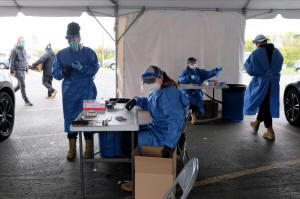COVID-19 cases surge in Wisconsin, Trump to campaign there
 Send a link to a friend
Send a link to a friend
 [October 17, 2020]
By Brendan O'Brien and Maria Caspani [October 17, 2020]
By Brendan O'Brien and Maria Caspani
CHICAGO (Reuters) - Two weeks ago, Mark
Schultz was getting ready to go to work at the tavern he owns in the
Wisconsin city of Oshkosh when he started to feel sweaty, achy and
chilled.
Within days, the 64-year-old was in an intensive care unit at a local
hospital fighting for his life.
Schultz, his 45-year-old fiance and his 10-year-old son are three of the
41,000 Wisconsinites who have tested positive for the virus over the
last two weeks, according to state health officials.
"I want people to know this is real. This is not a hoax. It's not fake
news like the president said," Schultz said.
Wisconsin has recently become an epicenter of the pandemic in the United
States.

On Friday, the state's department of health services reported grim
records as daily COVID-19 cases reached 3,861 and the seven-day average
of new confirmed cases topped 3,000 for the first time.
"This virus is unbelievable what it does to people," he said during a
phone interview with Reuters on Friday from his home, four days after
getting out of the hospital. "I literally thought I was taking my last
breath. It's like someone has a foot on your chest."
U.S. Surgeon General Jerome Adams, who traveled to Wisconsin to announce
the opening of a new testing facility in Neenah, told a news conference
on Friday that the state's cases and positivity rate were heading in the
"wrong direction."
Despite the surge in cases in Wisconsin, President Donald Trump plans on
Saturday to make a campaign stop in Janesville as he seeks to make up
for time lost during his own bout with the coronavirus earlier this
month.
"Wear a mask," Schultz said to those who plan to attend. "There is so
many unknowns with this thing. That is the scary part."
For a second day in a row, the United States reported more than 60,000
new coronavirus cases on Thursday as infections spike in all regions of
the country, according to a Reuters analysis.
The United States reported over 63,000 new cases on Thursday and over
60,000 new cases on Wednesday, a level on back-to-back days not seen
since late July and as total U.S. cases surpassed 8 million.
[to top of second column]
|

Personnel administer coronavirus disease (COVID-19) tests in
Milwaukee, Wisconsin, U.S., as cases spread in the Midwest, October
2, 2020. REUTERS/Alex Wroblewski

ELECTION NEARS
The surge in cases comes in the final weeks before the Nov. 3
presidential election. Trump has continued to minimize the threat to
public health posed by the virus that has killed more than 217,000
Americans and 1 million globally.
The rise in U.S. cases is beginning to tax hospitals in some
regions, with Wisconsin setting up a field hospital and reporting
that in some areas more than 90% of hospital intensive care unit
beds were filled as of Thursday.
The field hospital had yet to receive its first patient as of Friday
morning, according to a spokesperson for the Wisconsin Department of
Administration.
Meanwhile in Texas, Governor Greg Abbott said on Friday the state
was increasing medical personnel and supplies as well as personal
protective equipment for hospitals in Amarillo, Lubbock and
surrounding counties, which are seeing a rise in COVID-19
hospitalizations.
Deaths nationally remain fairly steady at 700 per day, but health
experts caution fatalities are a lagging indicator that rise weeks
after a surge in cases.

Deaths were already rising in several Midwest states over the past
two weeks compared with the prior two-week period, including
Arkansas, Illinois, Indiana, Iowa, Kansas, South Dakota and
Wisconsin.
(Reporting by Lisa Shumaker and Brendan O'Brien in Chicago,
additional reporting and writing by Maria Caspani in New York,
editing by Cynthia Osterman)
[© 2020 Thomson Reuters. All rights
reserved.] Copyright 2020 Reuters. All rights reserved. This material may not be published,
broadcast, rewritten or redistributed.
Thompson Reuters is solely responsible for this content. |